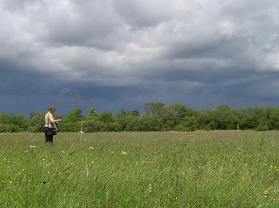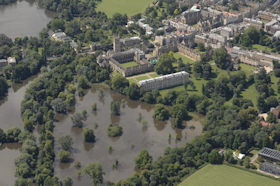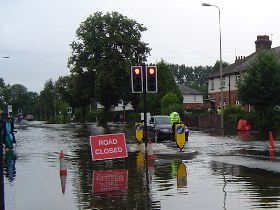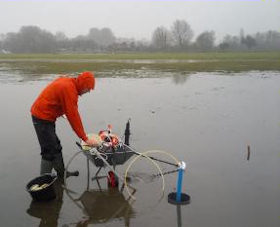Oxford field observatory
In recent years a series of studies have been undertaken by the BGS and collaborating organisations within the floodplain of the River Thames in the area around Oxford.
This area has now been established as a field observatory where baseline data are collected to benefit a number of research studies. Cross-fertilisation between studies will lead to a better understanding of the water environment.
The observatory also provides a location for the development and testing of innovative sampling methods, tracer applications and monitoring techniques.
Oxford and the Thames floodplain
Oxford is located in the upper reaches of the River Thames catchment. The Thames flows to the west of the historic centre of the city which stands on high ground above the current floodplain.
However, within the city more than 3000 properties, as well as major transportation routes and other infrastructure, are located on the Thames floodplain. The floodplain also includes farming land and ecologically sensitive sites.
The floodplain is underlain by shallow, highly permeable alluvial sediments and the water in the rivers and streams that flow across it are well connected to the groundwater within the sediments. Groundwater levels are generally no deeper than 2 m below ground level.
Environmental issues
Oxford is a city with many environmental pressures. In recent years, in particular 2007, flooding has caused damage to many properties and work is ongoing to understand the flood risks and to mitigate these.
These mitigation measures have the potential to affect natural flooding cycles and the ecosystems that depend on them.
These ecosystems are also potentially vulnerable to environmental change associated with longer term climate trends. In the peri-urban areas of Oxford, current and legacy human pollution provides a threat to the quality of water in aquifers, rivers and streams.
Studies to help address the environmental issues
The studies undertaken in the Oxford field observatory are described here, with links to more information. Although the field studies are located in the Oxford area, the results of the projects are of value across the UK and beyond.
- Groundwater and flooding in Oxford: collaborative work between the BGS and the Environment Agency, ongoing since 2005, has been investigating the mechanism for the extensive groundwater flooding that occurs within Oxford during high return flood events.
- Linking groundwater and river models for flood simulation: the BGS and HR Wallingford are undertaking a study to link existing groundwater and river models that cover the Oxford floodplain, to allow improved simulation of flood events. The models are being coupled using the OpenMI model interfacing system.
- Floodplain Underground Sensors (FUSE): a NERC-funded project within the Networks of Sensors Programme which aims to set up a high-density wireless sensor network to quantify floodplain hydro-ecological interactions. The study site is a Special Area of Conservation on the Thames floodplain upstream of Oxford.
- Floodplains and their role in contaminant attenuation: the BGS is investigating how the biogeochemical processes operating in floodplain environments affect the concentrations of urban-sourced groundwater contaminants reaching surface water courses. The Oxford floodplain is the case study area for the project.
- Fundamental aspects of particle interaction: the BGS, in collaboration with the NERC's Facility for Nanoparticle Characterisation at the University of Birmingham, is developing a robust method for sampling and characterising nanoparticles in anaerobic groundwater. The field sampling methodology has been developed on boreholes within the Oxford floodplain.
- Organic micropollutants in a peri-urban floodplain aquifer: the BGS has undertaken a pilot study within an area including a former landfill site in the Oxford floodplain to develop a sampling methodology required to investigate the occurrence and distribution of emerging organic contaminants in groundwater.
Contact
Contact David Macdonald for further information
- Investigating the interdependencies between surface and groundwater in the Oxford area to help predict the timing and location of groundwater flooding and to optimise flood mitigation measures
- Natural attenuation of anthropogenic groundwater pollution in a peri-urban floodplain setting
- Investigating organic micropollutants in a peri-urban flood plain aquifer










